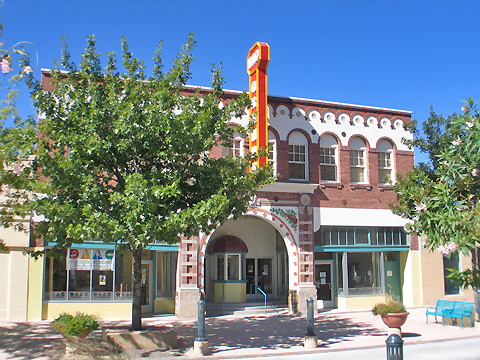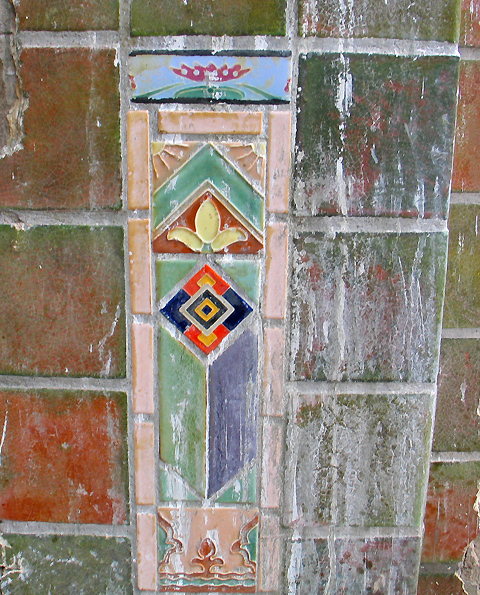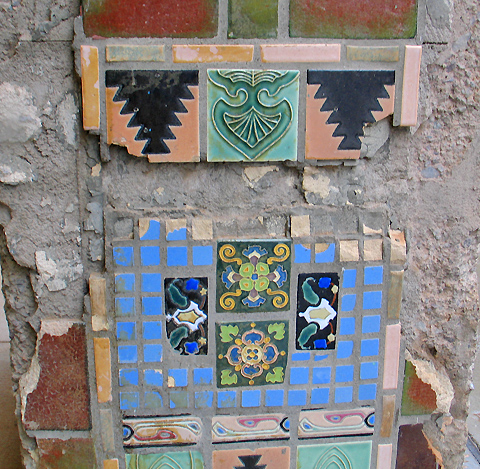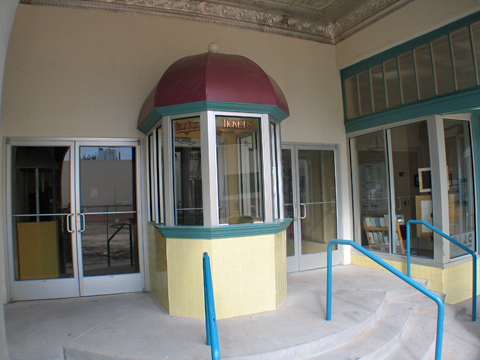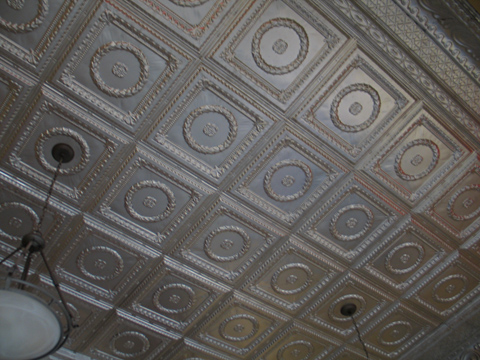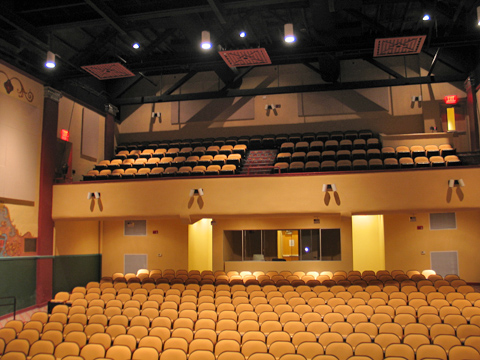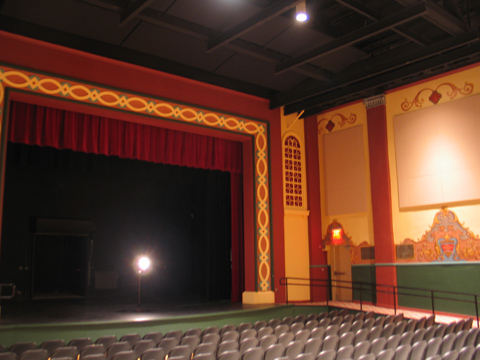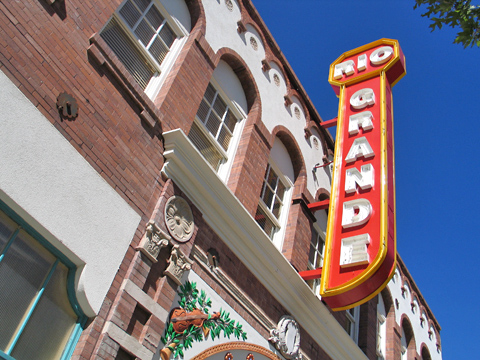THE RIO GRANDE THEATRE
The Rio Grande Theatre and the Doña Ana Arts Council
The Rio Grande Theatre, grande dame of Downtown Las Cruces, New Mexico, almost didn’t survive. In 1998, the Doña Ana Arts Council rescued the Rio Grande Theatre from certain destruction, and lovingly restored it into a Modern Performing Arts Center. The following article summarizes the unique history of the Theatre, along with the Arts Council’s role in its restoration, grand re-opening, and operation between the years of 1999 and 2017.
Rio Grande Theatre Historical Information
The Rio Grande Theatre was built in 1926 on the site of the Hacker Hotel.
Businessmen C. T Seale and B. G. Dyne built and continued to own the theatre until half was gifted to DAAC by the granddaughters of Mr. Seale (Jan Clute and Carolyn Muggenberg). DAAC acquired the remaining half and some initial demolition (such as removing the façade) began in 1998. It was soon discovered that it would be more than just a “weekend” project and the efforts to raise money for the renovation began. It would eventually take 7 years and $2.2 million (from private donations, federal, state and county money) for the RGT to re-open in September of 2005.
• The architect was Otto Thorman who did a number of buildings in El Paso. Original drawings were found at the UTEP library. (We have some enlarged copies of original architectural drawings). Building is done in the Italian Renaissance Revival style.
• The exterior of the front was uncovered to reveal the bas-relief violins, branches and trumpets as well as floral rosettes. Remaining color indicates that they were painted (note green leaves, brown branches and violins, and gold trumpets. Rosettes appear to have been yellow with dark centers.) The large rosettes were completely recreated as were the column caps. Some of the smaller rosettes had to be restored as well as the bell of one horn. The metal rosettes were connected to steel cables in the walls to help stabilize the building after the earthquake in the late 1920’s. Originally designed to be terracotta the front was eventually covered with brick with some terracotta around the base of the columns. The tile at the base of the columns is a hodgepodge of patterns (some of which go together to form a complete pattern – note the gold colored tiles on the north side of the north column; the three separated pieces form one design, as do the flower stems and buds on the bottom of that same column). The gold and black “pyramid” design has been identified as a pattern from the famous Malibu Tile company of Southern California (now Claycraft Tile). The inside of the columns featured a single column of tiles, the far sides of the north and south columns feature a field of tile three columns wide and photographs show that the front of each column had a field that was four tile columns wide.
• The sign was re-created to closely resemble the original one.
• The ticket booth was recreated from the original drawings.
• The galleries were a variety of small retail spaces during the years. The south side was a barber/beauty shop and later a jeweler (we have photos of both). Its last incarnation was a vitamin store. The north space was a ladies apparel store and a children’s store as well as a barbershop and was finally a trading card store. The fluted glass above the windows was re-created (note the differences between the central “swing-in” windows – one is divided into two panes the other is a slightly larger single pane.) The aluminum window frames separating the galleries from the steps leading up to the box office are clearly not square – there is a slope of several inches from back to front. This indicates how much the front of the building has sunk in 80 years and explains the large poles in the corners opposite the doors which were put in for support. The floor in the Clute/Muggenberg gallery falls away toward the outside (north wall) – one of the joys of restoring an 80 year old building. Things are not quite plumb and this contributes to its charm. Stairs are original and led from the street to the upstairs offices.
• The lobby originally had a snack bar – located just in front of where the double doors are now. Entrances to the auditorium were on either side and there were two staircases up to the balcony. A later version of the ticket booth was located in the area of the mirror and urn arrangement. The tin (actually aluminum for tin) ceiling was not in the original design – we just liked it and thought it added to the design (note lion faces in the corners). It also complements the column cap design in the auditorium. Each bathroom has the “optic” tile and a slightly different color scheme. The light fixtures were recently chosen because of their vintage feel.
• The auditorium originally had a center section and two side sections of seats, separated by two aisles. The auditorium now seats 422 (with 104 in the balcony). Our control room is now downstairs and houses our light board, sound board and digital projector. The original auditorium was the scene of a fire in 1933 and while the damage was minimal the theatre was closed and remodeled. The new décor was much more elaborate than the original design. Many features were added including the paintings on the walls. The color scheme was derived from the paintings on the walls which we were covered up for many years. Each cartouche is slightly different. They were all splendidly restored by local artist Alex Rosa. The “vents” that you see were part of the theatre’s “air washed” cooling system. Basically a “swamp cooler”, cool air was blown through a vent under the floor and it came out the side vents. However there were not as many vents as you were led to believe. Only every other vent was real – the others were painted on. Perhaps it was a psychological ploy to make us feel cooler or just to balance the actual vents in the cartouche design. The spaces on the wall where the acoustic panels now hang once were covered with white velour tapestries with red velvet festoons depicting historically or culturally significant figures – Carlos Rex, Coronado, a Spanish dancer, a Spanish padre, and Aztec chief and a Navajo Indian. The main drape was turquoise velvet with a gold plush valance and gold satin appliqué and was painted with the figures of caballeros in a falcon scene. There were nine great chandeliers that hung from the main ceiling and the main lobby was decorated with wall paintings and elaborate hangings symbolizing the spirit of the southwest. Color combinations of reds, yellows, and blues and gilded heraldic devices all in the Spanish baroque style. The column caps (complemented by the lobby ceiling) were in the original design but not executed most likely because of budgetary reasons. The balcony was the scene of many first dates, kisses etc and seated more than it does currently (some of the kids used to sit in the back and smoke). It is now steeper than in those days due to the extension of the front of the stage. Part of the balcony and projection room is now the DAAC conference room. The ceiling is original excluding the second truss from the east end which had some blackened areas so it was replaced with a metal one just to be on the safe side. The entire ceiling has been sprayed with black acoustical foam and we added our own ventilation system and catwalk. Above the adobe walls on either side of the balcony you can see clay brick finishing the walls up to the roof.
• The RGT is the oldest remaining two-story adobe theatre in the country and is on the National Historic Register. The front of the stage was originally just behind the current “proscenium” or picture frame that surrounds the stage opening. The arch details are a hard foam product that has been painted. The apron (in front of the curtain line) of the stage used to feature a small orchestra pit – filled in with cement long before we started renovation – and was the location of the pipe organ keyboard. Yes, like most theatres that played silent films, an organ was played along with the film before there were recorded soundtracks. Ours was a Wurlitzer and was registered with a serial number and is now owned by a private collector. The pipes were mounted on the backstage right (south wall). Since we could not go side to side for storage we installed a forty foot “fly” system – a series of pulleys and counterweights that lower scenery, curtains, and light bars out of the fly “loft” and raise them back up and out of the way. The upstage wall is the original adobe back wall of the theatre, the backstage dressing rooms – both upstairs and down – were added as was the load-in door and sprinkler system.
• The upstairs, that housed the DAAC offices from 2005 – 2017, was used for theatre offices and at one time housed a doctor’s office and as mentioned before, was the location of the projection room. The windows had to be recreated since they fell apart when trying to remove them. They no longer open or have screens as seen in some of the early photos.
The 10th Anniversary Re-opening Celebration in 2015.
Today
•The City of Las Cruces, instrumental as a fiscal agent for acquiring restoration funds from the New Mexico State Legislature, took over operation of the Rio Grande Theatre in June 2017. The theatre is now operated by the Convention and Visitors’ Bureau of the City of Las Cruces.
Photo credit: Emmitt Booher
